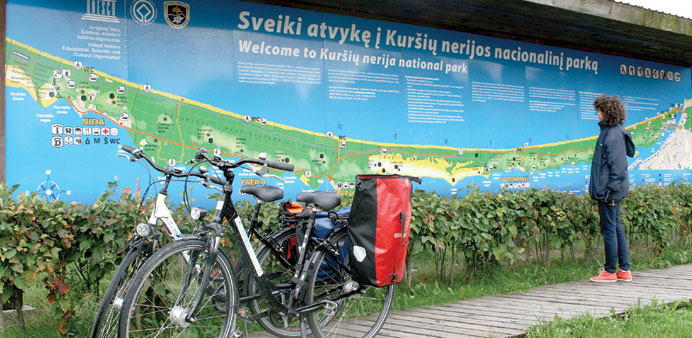THE MAP: At a maximum four kilometres wide, bicyclers have little chance getting off the right path.
By Nicole Jankowski
After scaling the steep sand hills called the Dead Dunes, bicyclists can enjoy an impressive view: To the left the eye takes in the Baltic Sea, to the right the Curonian Lagoon.
From here, it is only a few kilometres from Russia — and with that the end of the 200-kilometer-long Lithuanian costal road that began on the border with Latvia.
The road was opened in 2006 as the first continuously signposted road in the country. The symbol of a bicycle on blue background with the number 10 marks the way — as the roadway is part of the EuroVelo Route 10 that runs round the Baltic Sea, making it a terrific way to tour the Curonian Spit — thin projection of land off the Lithuanian’s coast.
The port city of Klaipeda, the third largest city in Lithuania, serves as the exit point for all bike tours. Those who travelled to Lithuania without their own bikes, can rent an appropriate one without any problem. Baltic Bike Travel has its headquarters in the town: 200 bikes are available, and helmets and child transporters can be rented.
Today there is a self-guided trip to Palanga. A well-kempt spa city around 27 kilometres north of Klaipeda, Palanga is Lithuania’s “secret summer capital” with spotless beaches.
It is also worth visiting there the former Palace of Count Felix Tiskevicius, home to the local amber museum, home to among other pieces the sunstone. At 3,526 grams it is the third-heaviest piece
of fossil amber in Europe.
In the parking lot, a bride and groom pose for their wedding photos. On the return trip to Klaipeda, one can see why the dreamlike scenery of the steep coast serves as the backdrop to a number of newlywed photos.
Boardwalks continually lead from the bike lane to the Baltic Sea shore — also popular as a meeting point for “girls’ nights,” family walks or romantic dates. Especially popular is the breathtaking scenery of the so-called Dutch Cap, a 24-metre high precipice.
On the next day begins the tour of the Curonian Spit National Park, which is also a Unesco World Cultural Heritage site. The Lithuanian part of the peninsula is 52 kilometres long.
From the harbour of Klaipeda, tour guide Inga Letinauskiene takes the bicycle tourists by ferry for 2.90 Lithuanian litas (a little over a dollar) over the lagoon to Smiltyne. For almost a half century, this
strip of mainland was unreachable by vacationers because of Soviet missile installations. Since then, a untold number of visitors have landed here. On the weekend it is especially popular with families visiting the local Sea Museum, equipped with its own dolphinarium.
On the spit — formed by more than 5,000 years of sand, wind and waves — everything is a bit rougher. Even the weather. And as you ride by bike, you are jostled even more as the wheels of your bike bounce over the no longer smooth bikepath. The path runs directly next to the road. Cars are scarce; instead there are deserted military buildings gone to ruin and a couple of locals with plastic buckets full of mushrooms biking by.
The path leads to the 42-meter tall Witch Mountain, one of the most beautiful dunes on the peninsula. Midsummernight was celebrated here until the first World War. Jonas Stanius, a forester from the local region Juodkrante, was inspired by the enchanted forests and called into life in 1979 a workshop for wood carvers. More than 80 friendly and sombre forms populate Witch Mountain — among which is the giant Neringa. At a little midday break with a bit of cheesecake gives enough time to listen to the fairytale about her.
The path runs further south, continually snaking its way through the light pine forests. The trees originate from Denmark, says Inga, and they have particularly wide roots. That way they keep the spit firm, she says.
Until the 19th century the movement of the sands regularly buried villages. The impressive Dead Dunes are a reminder of this. A path of timber planks leads up into an incomparable sand landscape that is constantly reformed by the wind. Sea, forest, dunes and lagoon as puzzle pieces. Now it is not far to Nida, with 1,500 inhabitants, the largest village on the peninsula. They are confronted with around 400,000 guests on the spit every season.
At the end of the 19th century, it was the peninsula’s insularity and the peculiar light that attracted numbers of expressionist artists to Nida. They worked and lived in a kind of artists’ colony. The most famous among them was writer Thomas Mann. From 1930 to 1933 he stayed here every summer, built a holiday house on Schwiegermutterberg — Mother-in-Law Mountain. Today the house contains an exhibition — available to those whose weary biker-legs are willing to negotiate the steep approach.
But before returning to the other side of the lagoon on the next day, some simply have to take a detour to the high dunes. At 60 meters tall it is one of the largest walkable dunes in Europe. Over 174 steps and boardwalks enable the sweat-producing climb. But the effort is well rewarded by breathtaking sights — nothing but sand, water, wind and clouds.
The naturalist Alexander Humboldt once said about the view: “The Curonian Spit is so remarkable, that seeing it is equally as important as having seen Spain and Italy, if you want to avoid depriving your soul of a wonderful image.” —DPA



